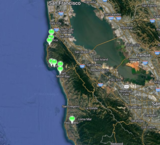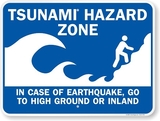Background
A tsunami is a series of sea waves usually caused by the displacement of the ocean floor by an undersea earthquake or landslide. As tsunamis enter shallow water near land, they increase in height and can cause great loss of life and property damage.
Research suggests that tsunami’s have struck the California coast many times in the past. They can occur any time, day or night. Typical wave heights from tsunamis occurring in the Pacific over the last 80 years have been 20-45 feet at the shoreline. Local conditions can sometime produce even larger waves. This video shows a tsunami that hit Japan in 2011.
We distinguish between a tsunami caused by a seismic event, such as an undersea earthquake, near the California coast (LOCAL SOURCE TSUNAMI) and one that occurs in another area of the Pacific Ocean (DISTANT SOURCE TSUNAMI).
A LOCAL SOURCE TSUNAMI could come onshore within 15-20 minutes after the earthquake-before there is time for official warning from national or local alert and warning systems.
Ground shaking from the earthquake may be the only warning you have. In the event of a strong earthquake (strong enough to make it difficult to stand) evacuate quickly to a safe area if you are located in a tsunami hazard zone!
A DISTANT SOURCE TSUNAMI may take several hours to come ashore. A distant source tsunami would allow time for officials to issue an official Tsunami Warning to seek higher ground away from the hazard areas.
Before the Tsunami
- Familiarize yourself with the Tsunami hazard zones on the San Mateo County Coastside.
- Assemble an EMERGENCY “GO KIT” to take with you when evacuating. MINUTES COUNT! Include in your kit:
- First aid kit and reference guide for its use
- Bottled water
- Food (packaged), snacks
- Blankets or sleeping bags
- Essential medications
- Cash
- Food for pets
- Portable radio, flashlight, and batteries.
- Watch this tsunami preparedness video: https://www.youtube.com/watch?v=x0GX_kc7JZo
If you feel a strong earthquake . . . Do not wait for official warning . . . a tsunami may be coming in a few minutes. Large waves may continue to come ashore for several hours.
Plan for Safe Boating
If you are on a boat when you receive a tsunami warning, your response time will depend on the size of the tsunami, the currents it produces, where you are, how much time you have before the first wave arrives and the weather at sea. If you are a boat owner or captain:
- Make sure you have a way to receive tsunami warnings when you are on the water. The U.S. Coast Guard will issue urgent marine information broadcasts on your marine VHF radio’s channel 16. Additional information will be available from NOAA Weather Radio.
- If you are on a boat in a harbor when you receive a tsunami warning, in general, you should plan to leave your boat and move quickly to high ground, or inland, away from the water. If you are at sea, you should plan to move to a safe depth of at least 180 feet and stay away from harbors under warning until officials tell you the threat has passed. Your harbormaster, port captain, the US Coast Guard, and San Mateo County and state emergency management offices are the best sources for tsunami safety information and regulations for boaters in San Mateo County.
- Make a plan and assemble a disaster supplies kit to keep on board your boat. Be aware that shore facilities may be damaged, so if you are out to sea during a tsunami, you may not be able to return to the harbor you left. Be prepared to remain at sea for a day or more.
During the Tsunami
- Protect yourself until the earthquake is over – drop, cover, and hold
- If a tsunami warning is issued, go to high ground, or inland immediately. If you are unable to evacuate to higher ground by foot, relocate to the upper floor (4th floor or higher) of a building.
- Travel on foot if at all possible, traffic will be very congested or gridlocked along coastal highways US 1, CA 84, and CA 92. Please keep roadways clear for emergency vehicles.
- Wait for an “all clear” from local emergency officials before returning to low-lying areas or the beach
Tsunami Sirens
If a tsunami warning is issued by NOAA (after the earthquake, but before the tsunami arrives), it will be announced over the Emergency Alert System (EAS) on commercial radios and televisions. It will also be sent over the NOAA weather all-hazard radio system, and the Integrated Public Alert and Warning System (IPAWS).
There are eight sirens on San Mateo County’s coastline between Pacifica and Pescadero (see photo below). In San Mateo County, these sirens are used exclusively for tsunami warnings. If you hear a steady 3-minute siren, seek higher ground at least 100 feet above sea level, or seek refuge on the 4th floor or higher in a building, or travel one mile inland and away from the coast. Tune your radio to KCBS 740 AM, or 106.9 FM, KQED 88,5 FM, KCSM 91.1 FM, or listen to your NOAA weather radio for official information.

Photo: San Mateo County Tsunami Siren Locations
San Mateo County’s Department of Emergency Management (DEM) will also provide county-specific information to affected San Mateo County coastal residents and visitors using the Federal Integrated Alert and Warning System (IPAWS). IPAWS includes an automated telephone notification system that will call phones in the tsunami hazard areas. The IPAWS system allows for the drawing of hexagon on a map around the affected areas. The system will then allow DEM to send emergency messages to all cell phones currently in that identified area.
San Mateo County will also send additional instructions and recovery information via text messages to cellular phones and email. You can sign up for this free service by going to smcalert.info and follow the instructions for “register now”.
As tsunami sirens have a limited range, in isolated areas along the beaches of San Mateo County you may not hear a warning siren. A SUDDEN CHANGE IN SEA LEVEL such as a rapidly receding sea should prompt you to go to high ground or inland immediately. Then, listen to your radio, television, or NOAA weather radio for official information.
Evacuation Guidance
In the event of a distance source tsunami, residents in the hazard areas will be instructed to seek higher ground (at least 100 feet above sea level), or to travel inland on foot at least one mile. Stay off the road as coastal highways will likely be gridlocked.
After the Tsunami
For All Tsunamis:
- Monitor radio (KCBS 740 AM, KQED 88.5 FM, KCSM 91.1 FM), television (KTVU TV-2, KRON TV-4, KPIX TV-5, KGO TV-7, KNTV-11), or NOAA Weather Radio for official information.
- If tsunami warning sirens sound, monitor the radio and seek higher ground (at least 100 feet above sea level, or the 4th floor (or higher) of a building).
- Stay away from low lying areas (beaches, bluffs, etc.).
- If you need help with evacuation, tie a large WHITE sheet or towel to your front doorknob so that it is visible from street. This will alert people that you need assistance.
What to do when sirens sound
- Seek higher ground immediately, at least 100 feet above sea level, or the 4th floor or above in a building.
- Travel by foot if at all possible – avoid traveling by car, coastal roadways will likely be gridlocked
- If unable to travel by foot to higher ground, seek the upper floors (4th floor or higher) of a nearby building.
- Have a designated meeting place and evacuation route and practice your plan.
- Know your child’s School evacuation plan.
- Have a Disaster Kit available.
For more information
NOAA Tsunami Warning Center – Frequently Asked Questions: https://www.tsunami.gov/?page=tsunamiFAQ
International Tsunami Information Center: http://itic.ioc-unesco.org/index.php?option=com_content&view=category&id=1270&Itemid=1270
FEMA – Tsunami / Special Conditions / On A Boat: https://community.fema.gov/ProtectiveActions/s/article/Tsunami-Special-Conditions-Locations-On-a-Boat
San Mateo County Harbor District: Tsunami PreparednessL https://www.smharbor.com/2021-tsunami-preparedness
KQED – What Would Really Happen if a Tsunami Hit the Bay Area?: https://www.kqed.org/news/10628782/what-would-really-happen-if-a-tsunami-hit-san-francisco
NOAA Tsunami Program: https://www.tsunami.noaa.gov/
NOAA Tsunami Information: https://www.noaa.gov/education/resource-collections/ocean-coasts/tsunamis
NOAA Tsunami Warning System: https://www.tsunami.gov/
NOAA – Tsunamis: Know the Signs: https://blog.response.restoration.noaa.gov/tsunamis-know-signs-hear-stories-and-get-prepared
